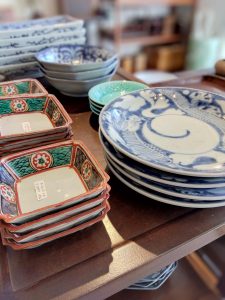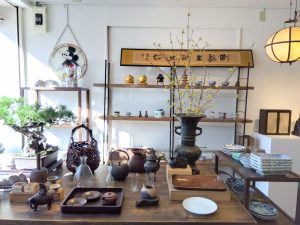衣裳も気になってきました(愛知県名古屋市千種区姫池通 骨董買取 古美術風光舎)
2025.02.09

大河ドラマ「べらぼう〜蔦重栄華乃夢噺〜」皆さまご覧になられていますでしょうか。
「光る君へ」が貴族の話でしたので、画面の色合いが白っぽいというか、上品な色合いだったのに対して、遊郭が舞台の「べらぼう」は鮮やかで、あと一歩で下品なのではというギリギリを攻めた色合いなのが面白いです。
普段どうしてもストーリーに気を取られて演出まで気がまわらないことがほとんどですが、こんなに画面の色合いで世界観の違いを出せるのだなぁという感想を持ちました。
そういった目線で見てみると、大河ドラマ「べらぼう」の世界に生きる人々の個性を際立たせる、多彩な衣装の数々も気になってきます。インタビューの中で、衣装を担当された伊藤さんは、「江戸の粋と意気を衣装で」表現されたと語っておられました。
江戸時代中期の衣装は色柄ともに多種多様。宮崎友禅斎(友禅染めの創始者)によって誕生した友禅染めは江戸の町人、吉原の花魁(おいらん)、武士の着物としても活躍。桃山時代に多用された絞りを友禅で絞り風の模様に染める“匹田染め”なども盛んになり、着物の色や柄を多種多様に変化させたと言われています。
江戸時代といえば藍色がベースの印象がありますが、「べらぼう」ではそこに柄ゆきの派手さも取り入れ、さらに江戸っ子が好きな茶色とねずみ色を効果的に配した衣装をデザインして工夫されたそうです。
また、衣装を考えるうえで浮世絵(喜多川歌麿、東洲斎写楽、鳥居清長など)も参考にされたそう。
浮世絵に描かれている人物を見ると、町人を含めてみな襟元が“ぐずっ”としていて、きっちりと襟を合わせて着ている人はいません。
そこで「べらぼう」の作中では襟元をゆるやかに着付けることにこだわったのだそう。“ぐずっ”とした襟元で大事なのが半襟で、長年趣味で集めておられた江戸裂(えどぎれ)を使われたのだとか。面白い柄ゆきが多くそれだけで江戸の雰囲気を醸し出してくれそうですね。
そして主人公の蔦重の着物に使われた色は、一般的な藍色ではなく緑色です。
ご存知の通り、緑色の作り方は「青色」+「黄色」の混色です。単色では色が出ない、他の色と掛け合わせることで染め上がる緑色を使った理由は、「まだ何者でもない蔦重が何にも縛られず、やんちゃで発想豊かに新しいものを生み出していく。そんなオリジナリティーあふれる人生のスタートを象徴する色」として、たやすく再現できない緑という色選んだのだそうです。
この蔦重の衣装は、綿つむぎという白生地を緑色に染めたのだそうですが、理想の色になるまで3回も染め直しているのだそう。また緑一色ではなく細い黒縞(くろしま)を入れて蔦重の動き、若々しさや躍動感が際立つようにしているのだとか。
そしてドラマの前半、蔦重の着物はなんとこれ一着。着物を通して人物像を視聴者に伝える。そんな衣装の演出的な考え方がとても面白いと思いました。
その他、吉原の親父たちの全員が並んだときの色の構成やバランスが考えられた衣装もまた見どころ。今後は、俳優さんたちのアップが映る画面では襟元にも注目したいと思います。当時好まれたカチムシ(トンボ)の絵柄の半襟も見られるかもしれません。
とりあえず、今日も今日とて横浜流星のお顔とお声が素晴らしい(もちろんそれだけではありません!)。放送が楽しみです。
ではでは、また。(スタッフT)

I hope everyone is watching the historical drama “Belabo – Tsutaju Eika no Yume Banashi” (Belabo – Tsutaju’s Dream Story).
It is interesting to note that while “To the Luminous Kimi” was a story about an aristocrat and the colors on the screen were whitish or elegant, “Belabo,” which takes place in a brothel, is vivid and just on the verge of vulgarity.
Usually, I am so preoccupied with the story that I do not pay attention to the production, but I was impressed by the difference in the worldview that can be created by the coloring of the screen.
Looking at it from this perspective, I was also interested in the variety of costumes that accentuate the personalities of the people living in the world of the “Bekabo” drama.
I was also interested in the various costumes that accentuate the personalities of the people who live in the world of the drama. In an interview, Mr. Ito, who was in charge of the costumes, said that he tried to express “the spirit and sophistication of Edo with the costumes.
The costumes of the mid-Edo period were made with colorful patterns and patterns.
Costumes of the mid-Edo period were diverse in color and pattern. Yuzen dyeing, created by Miyazaki Yuzenzai (the founder of yuzen dyeing), was used by Edo merchants, Yoshiwara oiran (courtesans), and samurai warriors. The yuzen dyeing technique called “Hitta Dyeing,” in which a tie-dyeing technique used in the Momoyama period to create tie-dye-like patterns, also became popular, and is said to have changed the colors and patterns of kimono in a wide variety of ways.
The Edo period is known for its indigo-based colors, but “BEROBO” incorporated flamboyant patterns into its costumes, which were designed to effectively use brown and gray, the colors favored by the Edo people.
He also referred to Ukiyoe (works by artists such as Utamaro Kitagawa, Sharaku Toshusai, and Kiyonaga Torii) when designing his costumes.
When looking at the people depicted in Ukiyoe, the collars of all the people, including the townspeople, are “sloppy” and no one is wearing a tightly fitted collar.
Therefore, in the production of “Bebo,” the artist was particular about wearing the collars loosely. The most important part of the “staggered” collar is the half collar, which is made of Edo-style fabrics that he had collected as a hobby over the years. There are many interesting patterns, which alone seem to create the atmosphere of Edo.
The color used for the main character Tsutajige’s kimono is not the common indigo color, but green.
As you know, green is made by mixing “blue” + “yellow. The reason for using green, which is a color that cannot be produced by a single color and can be dyed by multiplying it with other colors, is that “Tsutae, who is still a nobody, is not bound by anything and creates new things in a mischievous and imaginative manner. He chose the color green, which cannot be easily reproduced, as “a color that symbolizes the start of a life full of such originality.
The ivy-jaye’s costume was dyed green from a white fabric called “cotton twine,” and it was re-dyed three times until the ideal color was achieved. Also, instead of using only green, thin black stripes were added to accentuate Tsutajige’s movement, youthfulness, and dynamism.
In the first half of the drama, Tsutajige wears only one kimono. The viewer is given a portrait of the character through the kimono. I thought such a directorial approach to costume design was very interesting.
Other highlights of the costumes are also the thoughtful color composition and balance of the Yoshiwara fathers when all of them are lined up in a row. In the future, I would like to pay attention to the collars when the screen shows close-ups of the actors. We may even see the half collars with the kachimushi (dragonfly) design favored at the time.
At any rate, Ryusei Yokohama’s face and voice are wonderful (and not just because of that). I am looking forward to the broadcast.
See you later. (Staff T)
*****************
ご実家の整理やお片付けなどをされている方のご相談などが多くございます。
お片付けなどくれぐれもご無理のないようになさってくださいませ。
風光舎では古美術品や骨董品の他にも絵画や宝石、趣味のお品など様々なジャンルのものを買受しております。
お片付けをされていて、こういうものでもいいのかしらと迷われているものでも、どうぞお気軽にご相談下さいませ。
また風光舎は、出張買取も強化しております。ご近所はもちろん、愛知県内、岐阜県、三重県その他の県へも出張いたします。
まずは、お電話お待ちしております。
愛知県名古屋市千種区姫池通
骨董 買取【古美術 風光舎 名古屋店】
TEL052(734)8444
10:00-18:00 OPEN
#出張買取#骨董#古美術#骨董品#絵画#版画#茶道具#刀剣#彫刻

